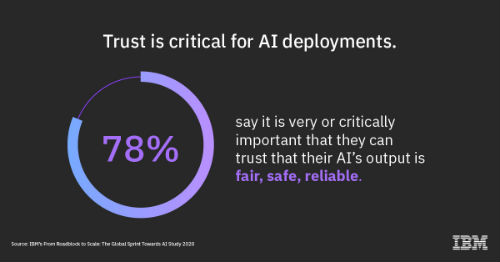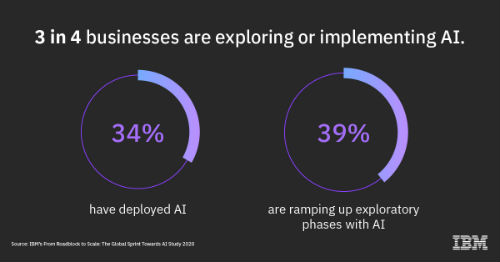AI
AI in 2020: From Experimentation to Adoption
January 3, 2020 | Written by: Rob Thomas
Categorized: AI | Artificial Intelligence | Data Science | IBM Watson | Innovation
Share this post:
 AI has captured the imagination and attention of people globally. But in the business world, the rate of adoption of artificial intelligence has lagged behind the level of interest through 2019. Even though we hear that most business leaders believe AI provides a competitive advantage, up until recently, some industry watchers have pegged enterprise adoption at less than 20%.
AI has captured the imagination and attention of people globally. But in the business world, the rate of adoption of artificial intelligence has lagged behind the level of interest through 2019. Even though we hear that most business leaders believe AI provides a competitive advantage, up until recently, some industry watchers have pegged enterprise adoption at less than 20%.
But as we enter 2020, we’re spotting an uptick, not only in interest but in AI adoption. And that uptick is reaffirmed by a recent global survey commissioned by IBM. The survey, From Roadblock to Scale: The Global Sprint Towards AI, polled more than 4,500 technology decision makers. We wanted to gauge the current and future states of AI deployment across the U.S., Europe and China, to better understand the landscape and the challenges. As you’ll see, it’s about to change dramatically.
AI Adoption on the Rise
Results from the Roadblocks to Scale survey indicate that while there is still work to be done, advances in data discovery and management, skills training and AI explainability are driving the rate of AI adoption faster than many predicted.
For example, 45% of the respondents from large companies (1,000+ employees) said they have adopted AI, while 29% of small and medium sized businesses (under 1,000 employees) responding said they have adopted the technology. These numbers are significantly higher than some industry watchers have estimated to date. Some of the more telling data points of the survey, for which the Executive Summary can be found here, include the following:
A Glimpse at the Numbers
- Skills. Major roadblocks are still holding companies back from the benefits of AI. Amongst respondents, 37% cite limited AI expertise or knowledge as a hinderance from successful AI adoption at their business, with increasing data complexities and siloed data (31%) and lack of tools for developing AI models (26%) following close behind.
- Trust. Trust is part of the bedrock of AI’s deployment. Globally, 78% of respondents across all countries surveyed say it is very or critically important that they can trust that their AI’s output is fair, safe, and reliable. Moreover, being able to explain how AI arrived at a decision is universally important (83% of global respondents).
- Data. Companies currently deploying AI technologies are more likely to use a hybrid cloud (38% adopted) or hybrid multicloud (17% adopted), as AI success is fed by data. And, data is everywhere, on all clouds.
The AI Journey Streams Across the Business World
 Based on our interactions and the results of this study, we expect to see organizations not only adopt AI – but scale it across their enterprises, by building/developing their own AI, or putting ready-made AI applications to work. For example, according to the survey, 40% of respondents currently deploying AI said they are developing proof-of-concepts for specific AI-based or AI-assisted projects, and 40% are using pre-built AI applications, such as chatbots and virtual agents.
Based on our interactions and the results of this study, we expect to see organizations not only adopt AI – but scale it across their enterprises, by building/developing their own AI, or putting ready-made AI applications to work. For example, according to the survey, 40% of respondents currently deploying AI said they are developing proof-of-concepts for specific AI-based or AI-assisted projects, and 40% are using pre-built AI applications, such as chatbots and virtual agents.
I see the excitement building with clients every day. Consider just a couple of recent examples. Legal software developer LegalMation has leveraged IBM Watson and our natural language processing technology to help attorneys automate some of the most mundane litigation tasks, speeding, for example, the written discovery process from multiple hours to a few minutes.
Wunderman Thompson Data, the global digital agency, uses Watson Studio and Watson Machine Learning to access, analyze and run models on terabytes of data stored across its hybrid multicloud environment. As part of its work with Watson Machine Learning, Wunderman is also using IBM AutoAI to automate models to analyze literally tens of thousands of features from across the company’s datasets.
 When I look at insights from the report, which was conducted by the firm Morning Consult, and think about my interactions with clients, the roadblocks to AI adoption have been a prime concern. They’re the reason we’ve worked to lower the barriers of entry and make AI more accessible to businesses.
When I look at insights from the report, which was conducted by the firm Morning Consult, and think about my interactions with clients, the roadblocks to AI adoption have been a prime concern. They’re the reason we’ve worked to lower the barriers of entry and make AI more accessible to businesses.
It’s why we launched the Data Science Elite Team in 2018, a global group of experienced technical professionals who help companies solve real problems with AI. It’s what drove us to introduce innovations like Watson OpenScale, to help mitigate bias in AI models; Watson AutoAI, which literally uses AI to build AI models; and it’s what led us to create the first-of-its-kind container-based data analytics platform, Cloud Pak for Data, that lets people run Watson on any cloud. We’ve also, taken skills training and support to whole new levels, with robust data science work with several open standards bodies, such as The Open Group and The Linux Foundation.
2019 was a productive year for AI, but 2020 is shaping up to bring an exciting new level of commitment and with it, exciting new outcomes for all involved.
___________________________________________
Executive Summary: From Roadblock to Scale: The Global Sprint Towards AI

Senior Vice President, IBM Cloud and Data Platform
On Another Apollo Anniversary, a Reminder: IBM Space Technology Continues to Evolve
History’s publicists have done well by Apollo 11 and Neil Armstrong’s first moon steps in July 1969. However, fewer recall the Apollo 12 lunar mission four months later. It almost didn’t happen. On Nov. 14, 1969, in the first minute after lift-off, two lightning bolts struck Apollo 12. The spacecraft’s main power supply went dark, […]
The 3 Beachheads of AI
(Part 2 in a Series) We have been partnering with and assisting clients on their data needs and strategies for years. It’s clear that data and AI are two-sides of the same coin; in fact, this understanding spawned the AI Ladder concept. We’ve developed skills training in the areas of data science and machine learning; […]
The Apollo 11 Lessons We Live by Today
In 1969, more than 4,000 IBMers worked alongside NASA to land Apollo 11 on the moon. And for each day of the many months they worked writing code, programming computers and running simulations, they never stopped thinking: What else could we do? What contingency can we plan for? What are we forgetting? In fact, it […]


